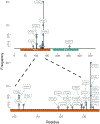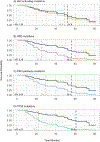Clinical and genomic features of SPOP-mutant prostate cancer
- PMID: 34783071
- PMCID: PMC8688331
- DOI: 10.1002/pros.24269
Clinical and genomic features of SPOP-mutant prostate cancer
Abstract
Background: Inactivating missense mutations in the SPOP gene, encoding speckle-type poxvirus and zinc-finger protein, are one of the most common genetic alterations in prostate cancer.
Methods: We retrospectively identified 72 consecutive prostate cancer patients with somatic SPOP mutations, through next-generation sequencing analysis, who were treated at the Johns Hopkins Hospital. We evaluated clinical and genomic characteristics of this SPOP-mutant subset.
Results: SPOP alterations were clustered in the MATH domain, with hotspot mutations involving the F133 and F102 residues. The most frequent concurrent genetic alterations were in APC (16/72 [22%]), PTEN (13/72 [18%]), and TP53 (11/72 [15%]). SPOP-mutant cancers appeared to be mutually exclusive with tumors harboring the TMPRSS2-ERG fusion, and were significantly enriched for Wnt pathway (APC, CTNNB1) mutations and de-enriched for TP53/PTEN/RB1 alterations. Patients with mtSPOP had durable responses to androgen deprivation therapy (ADT) with a median time-to-castration-resistance of 42.0 (95% confidence interval [CI], 25.7-60.8) months. However, time-to-castration-resistance was significantly shorter in SPOP-mutant patients with concurrent TP53 mutations (hazard ratio [HR] 4.53; p = 0.002), HRD pathway (ATM, BRCA1/2, and CHEK2) mutations (HR 3.19; p = 0.003), and PI3K pathway (PTEN, PIK3CA, and AKT1) alterations (HR 2.69; p = 0.004). In the castration-resistant prostate cancer setting, median progression-free survival was 8.9 (95% CI, 6.7-NR) months on abiraterone and 7.3 (95% CI, 3.2-NR) months on enzalutamide. There were no responses to PARP inhibitor treatment.
Conclusions: SPOP-mutant prostate cancers represent a unique subset with absent ERG fusions and frequent Wnt pathway alterations, with potentially greater dependency on androgen signaling and enhanced responsiveness to ADT. Outcomes are best for SPOP-altered patients without other concurrent mutations.
Keywords: RNA sequencing; SPOP; predictive biomarkers; somatic mutations.
© 2021 Wiley Periodicals LLC.
Figures



Similar articles
-
Association of SPOP Mutations with Outcomes in Men with De Novo Metastatic Castration-sensitive Prostate Cancer.Eur Urol. 2020 Nov;78(5):652-656. doi: 10.1016/j.eururo.2020.06.033. Epub 2020 Jul 2. Eur Urol. 2020. PMID: 32624276 Free PMC article.
-
SPOP and FOXA1 mutations are associated with PSA recurrence in ERG wt tumors, and SPOP downregulation with ERG-rearranged prostate cancer.Prostate. 2019 Jul;79(10):1156-1165. doi: 10.1002/pros.23830. Epub 2019 May 15. Prostate. 2019. PMID: 31090082
-
SPOP-Mutated/CHD1-Deleted Lethal Prostate Cancer and Abiraterone Sensitivity.Clin Cancer Res. 2018 Nov 15;24(22):5585-5593. doi: 10.1158/1078-0432.CCR-18-0937. Epub 2018 Aug 1. Clin Cancer Res. 2018. PMID: 30068710 Free PMC article.
-
Updates on SPOP Gene Mutations in Prostate Cancer and Computational Insights From TCGA cBioPortal Database.Scientifica (Cairo). 2025 May 20;2025:4084224. doi: 10.1155/sci5/4084224. eCollection 2025. Scientifica (Cairo). 2025. PMID: 40432836 Free PMC article. Review.
-
The emerging role of speckle-type POZ protein (SPOP) in cancer development.Drug Discov Today. 2014 Sep;19(9):1498-502. doi: 10.1016/j.drudis.2014.07.009. Epub 2014 Jul 21. Drug Discov Today. 2014. PMID: 25058385 Free PMC article. Review.
Cited by
-
Comprehensive analysis of TP53 and SPOP mutations and their impact on survival in metastatic prostate cancer.Front Oncol. 2022 Aug 31;12:957404. doi: 10.3389/fonc.2022.957404. eCollection 2022. Front Oncol. 2022. PMID: 36119488 Free PMC article.
-
The evolving landscape of prostate cancer somatic mutations.Prostate. 2022 Aug;82 Suppl 1(Suppl 1):S13-S24. doi: 10.1002/pros.24353. Prostate. 2022. PMID: 35657155 Free PMC article. Review.
-
Cuproptosis-related lncRNAs emerge as a novel signature for predicting prognosis in prostate carcinoma and functional experimental validation.Front Immunol. 2024 Oct 28;15:1471198. doi: 10.3389/fimmu.2024.1471198. eCollection 2024. Front Immunol. 2024. PMID: 39530098 Free PMC article.
-
Generation of prostate cancer assembloids modeling the patient-specific tumor microenvironment.PLoS Genet. 2025 Mar 31;21(3):e1011652. doi: 10.1371/journal.pgen.1011652. eCollection 2025 Mar. PLoS Genet. 2025. PMID: 40163511 Free PMC article.
-
CHD1 loss reprograms SREBP2-driven cholesterol synthesis to fuel androgen-responsive growth and castration resistance in SPOP-mutated prostate tumors.Nat Cancer. 2025 May;6(5):854-873. doi: 10.1038/s43018-025-00952-z. Epub 2025 May 13. Nat Cancer. 2025. PMID: 40360905 Free PMC article.
References
Publication types
MeSH terms
Substances
Grants and funding
LinkOut - more resources
Full Text Sources
Medical
Research Materials
Miscellaneous

